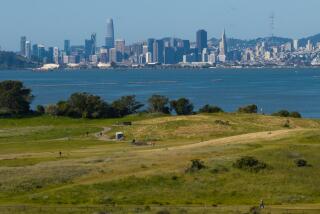Unnecessary Alliance Confuses the Issue : Nuclear medicine’s needs not the same as nuclear power’s
- Share via
Over the last year The Times has published a series of editorials challenging a plan to open a low-level radioactive waste dump at Ward Valley, 23 miles from the Colorado River. But if Ward Valley is not the answer, what is?
There are, in fact, several answers because several different kinds of waste carry, inappropriately, the same “low-level” label. The beginning of an economically feasible, environmentally acceptable answer to the problem is to take the lid off this category and look inside. Much of the waste from nuclear medicine becomes harmless in a month or less. Some of the waste from nuclear power plants remains lethal for thousands of years. Britain and a number of other countries distinguish the two as low-level and intermediate-level waste. When this country begins to do the same, it will begin to develop appropriately different solutions for different waste disposal problems.
NO SOLUTION: The real interests of nuclear medicine, in particular, have not been well-served by a determination to seek a one-size-fits-all solution that would also meet the needs of nuclear power. By comparison with the hundreds of hospitals and universities where nuclear medicine or medical research is practiced, there are only a few nuclear power plants. And even though much of the plants’ waste is far more hazardous than nuclear medical waste, it is stored for the time being at the nuclear power stations. If the combination of Ward Valley as site and U.S. Ecology as operator proves unacceptable, the power industry is well-positioned to wait until a better site and a better operator can be found. The same is not true for medicine.
The moment may thus have come for the medical community to revisit its 1991 decision to make common cause with nuclear power. The medical community has made important recent strides in on-site disposal of nuclear waste. The Mayo Clinic in Rochester, Minn., which built its first on-site disposal facility in 1984, has cut its need of shipment to off-site facilities from 900 barrels per year to zero at an annual savings of $2.5 million. Comparable measures are in place or under development at many California locations. Off-site disposal of some waste remains indispensable; but once transportation and packaging costs have been factored in, the disposal solution of choice for relatively short-lived biotech/bio-med waste will almost certainly not be the Ward Valley one of remote, shallow burial in unlined trenches. This solution, dictated by the requirements of long-lived nuclear power waste, has only been viable for nuclear medicine because by adding the far greater volume of power generators’ waste, a dump operator could spread costs among a greater number of users. That prima facie economic advantage to medicine, questionable in any event, must be weighed against several disadvantages, including the delay that nuclear power can afford so much more easily than nuclear medicine can.
NO SALE: Carol Marcus, director of the Nuclear Medicine Outpatient Clinic at UCLA, complained in a June 30, 1992, letter to Ivan Selin, Nuclear Regulatory Commission chairman, that the nuclear medicine/nuclear power alliance had not worked out for nuclear medicine. “Nuclear power utility employees,” she said, “have been told by their corporate leaders to remain silent and unseen and let the biomedical and academic sectors ‘sell’ a LLRW (low-level radioactive waste) site.” But the Ward Valley site has not yet been “sold,” and nuclear medicine is worse off than if it had sought public assistance in developing a facility for aboveground storage until its waste decays.
Such facilities can be developed. Precedent is abundant. But none will be developed until the medical community begins to address its own needs as its own, with a tacit admission that the omnibus “low-level” category is decreasingly useful.






